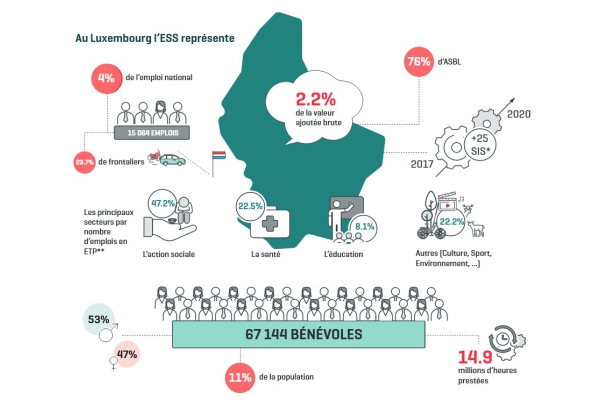 Credit: STATEC
Credit: STATEC
On Tuesday 21 June 2022, Luxembourg's statistics agency Statec published figures of the social and solidarity economy (l'économie sociale et solidaire - SSE), a sector which brings together all the actors whose main objective is a social cause.
These objectives include, among others: social action, health, bio-economy and the environment, culture, education, sport, or unions and political parties. Together, this sector represents 2.2% of national gross added value (gross domestic product - GDP) and 4% of national employment in 2020.
The SSE encompasses organisations and enterprises that: 1) have explicit economic and social (and often environmental) objectives; 2) maintain, in various forms and to varying degrees, cooperative, associative and supportive relationships between workers, producers and consumers; 3) practice democracy and self-management at work.
The SSE includes traditional forms of cooperatives, mutuals, as well as women's self-help groups, community forestry groups, social welfare or "proximity service" organisations, fair trade organisations, associations of informal sector workers, social enterprises and community money and alternative financing systems.
The ESS recognises six legal forms:
- Associations: Asbl "non-profit organisations" (1,627); Other associations (366); Agricultural associations (40);
- Foundations (32);
- Societal impact companies (SIS) (25);
- Other non-market entities (28);
- Mutuals (10);
- Cooperatives (7).
The social and solidarity economy is a labour-intensive economy.
In 2020, it represented 4% of total employment, which corresponds to 0.8% of national production. On average, SSE production grows 4.0% faster than national production and employment grows 0.2% faster.
Furthermore, in 2020, 1,627 of the 2,135 SSE entities were non-profit organisations, i.e. 76.2% of the total. Foundations, mutuals, cooperatives and SIS represented 74 entities, or 3.5% of the total. Agricultural associations (40 entities or 1.9%) and other associations that do not have the legal form of asbl (394 entities or 17.4%), completed the ESS.
The asbl represent 79.1% of jobs in 2015 and this share increased to 81.6% in 2020. In absolute figures, non-profit organisations increased from 12,212 full-time jobs in 2015 to 15,064 in 2020. Employment in the other entities is much more volatile and fluctuated from year to year, except at the SIS where it went from 72 in 2017 (year of creation of this legal form) to 479 in 2020.
Contrary to national employment, the proportion of cross-border workers is relatively low in the SSE with 23.7% in 2020. Only agricultural associations and foundations show a high rate of cross-border workers, with on average over the 2015-2020 periods, 52.1% cross-border work for agricultural associations and 45.2% for foundations.
A survey of volunteers in 2020 showed that a total of 14,939,945 hours were worked. Women worked 45.1% of these hours. However, the gender balance depends on voluntary activity. Activities with predominantly female volunteers are the defence of social rights and charitable activities (84.9% of hours worked by women). More women than men were involved in political parties or trade unions (59.7%), community activities and social services (55.4%) and culture (51.1%). Men were more involved in sports (80.5%), professional associations (83.9%) and other activities (59.7%).
The SSE in figures in 2020:
- Number of entities active in the SSE: 2,135 (including 76.2% non-profit organisations).
- Number of entities created between 2015 and 2020: 51 (including 25 SIS).
- The major SSE families: 1,627 asbl, 366 other associations, 40 agricultural associations, 32 foundations, 25 SIS, 28 other non-market entities, 10 mutuals and 7 cooperatives.
- Number of jobs (full-time equivalent): 15,064 (including 23.7% occupied by cross-border workers).
- The SSE represents 4% of national employment.
- Number of volunteers: 67,144 (including 47% women), i.e. 11% of the population.
- Hours worked by volunteers: 14.9 million.
The publication is available online via: https://statistiques.public.lu/en/publications/series/regards/2022/regards-04-22.html.








